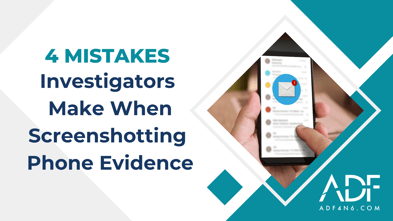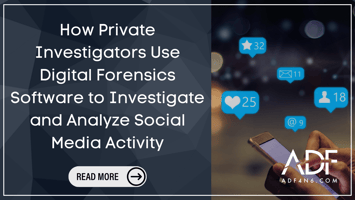Digital forensics software serves as the backbone of contemporary investigative work. Today,...
4 Mistakes Investigators Make When Screenshotting Phone Evidence
Today, screenshots have become a valuable tool for capturing critical evidence from mobile devices in digital forensic investigations. While screenshots can provide visual evidence of text messages, social media posts, and other digital content, investigators must exercise caution to ensure the accuracy and authenticity of the collected evidence. The admissibility of digital forensic screenshots as evidence in a court of law relies on meeting various legal, technical, and procedural requirements.
ADF's Mobile Device Investigator (MDI) software is an essential tool for frontline field investigators who need to capture screenshots and screen recordings of digital evidence on iOS and Android mobile devices. To ensure that these screenshots carry weight in court and contribute to a fair and just resolution of the case, investigators must be diligent in their collection, authentication, and documentation processes. Using the right digital forensic software and using it correctly can help them accomplish this task.

Here are four common mistakes investigators make when screenshotting phone evidence:
- Failure to Establish Authenticity:
One of the most significant mistakes investigators make is failing to establish the authenticity of the screenshots. Authenticity is crucial to ensure that the screenshots have not been altered or manipulated, as any changes could cast doubt on the integrity of the evidence. To avoid this, investigators must document the process of capturing the screenshots, including the date, time, and device used. Additionally, using specialized software, like ADF's Mobile Device Investigator (MDI), can help create a tamper-proof record of the screenshots, providing a strong foundation for their admission in court. - Neglecting the Chain of Custody:
Maintaining a proper chain of custody is essential in any digital forensic investigation. It is a written record that documents the handling and transfer of evidence from one person to another. Failing to maintain a strict chain of custody can lead to challenges regarding the integrity of the screenshots. Investigators should always document who handled the device, when, and for what purpose. This ensures that the screenshots remain untampered and can be presented confidently in court. - Ignoring Jurisdiction-Specific Admissibility Rules:
Different jurisdictions may have varying rules and standards regarding the admissibility of digital evidence, including screenshots. These rules may dictate the format, technical specifications, and procedures for presenting such evidence in court. Ignoring these jurisdiction-specific admissibility rules can jeopardize the credibility of the screenshots and potentially lead to their exclusion as evidence. Investigators should be well-versed in the relevant legal requirements and ensure that the screenshots meet all necessary criteria. - Overlooking the Need for Expert Testimony:
In complex cases or situations where the significance of the screenshots might not be apparent to the court, expert testimony can play a crucial role. Digital forensic examiners can provide insights into the processes used to capture the screenshots, the software or tools' reliability, and the interpretation of the data within the screenshots. By presenting expert testimony, investigators can strengthen the credibility of the evidence and help the court understand its importance in the context of the case.
Screenshots of mobile device evidence can be powerful tools in digital forensic investigations, but only if they are collected and handled properly. Investigators must ensure the authenticity of the screenshots, maintain a strict chain of custody, adhere to jurisdiction-specific admissibility rules, and consider the need for expert testimony when necessary. By avoiding these mistakes and following best practices, investigators can present compelling and convincing evidence in court, helping to deliver justice and uphold the rule of law.
Prove your Case with Mobile Device Investigator
MDI simplifies the process for digital evidence investigators to strengthen their cases by equipping them with robust tools to extract, analyze, and present data from mobile devices. This software enables investigators to gather a wealth of evidence, enhance their analytical capabilities, and deliver more compelling presentations in court.
Frontline field agents and digital investigators can utilize MDI to record their findings and offer concise or detailed explanations of the evidence observed during the acquisition phase of the investigation. Documenting the significance of their findings at the time of the investigation will provide valuable context and clarity for future analysis and courtroom presentation.
Utilizing ADF's Mobile Device Investigator (MDI) can further enhance the reliability and accuracy of the screenshots, ultimately strengthening the overall case presentation. MDI software is a crucial asset for frontline field investigators requiring the capture of screenshots and screen recordings from iOS and Android mobile devices. Utilizing this tool empowers investigators to accumulate a greater volume of evidence, enhance their analytical capabilities, and present a more compelling case in court. Whether you are part of a law enforcement agency, a prosecutor, or an investigator, MDI offers the means to strengthen your case and ensure justice is served.





